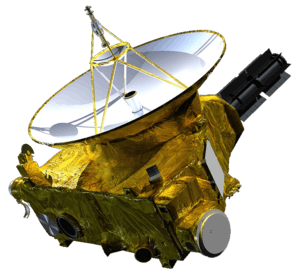Dragonfly (spacecraft)
Dragonfly is a planned spacecraft and mission of NASA, that will send a mobile robotic rotorcraft lander to Titan, the largest moon of Saturn, in order to study prebiotic chemistry and extraterrestrial habitability at various locations where it will perform vertical-takeoffs and landings (VTOL).[5][6][7]
 Mission concept illustration | |
| Mission type | Astrobiology reconnaissance |
|---|---|
| Operator | NASA |
| Website | dragonfly |
| Mission duration | Science phase: 2.7 years[1] |
| Spacecraft properties | |
| Spacecraft | Dragonfly |
| Spacecraft type | Rotorcraft lander |
| Manufacturer | Johns Hopkins Applied Physics Laboratory |
| Landing mass | ≈450 kg (990 lb)[2] |
| Power | 70 W (desired)[2] from an RTG |
| Start of mission | |
| Launch date | April 2026[1] |
| Rocket | Atlas V 411 or equivalent[3] |
| Titan aircraft | |
| Landing date | December 2034[1] |
| Landing site | Shangri-La dune fields[4] |
| Distance covered | 8 km (5.0 mi) per flight (planned)[4] |
Titan is unique in having an abundant, complex, and diverse carbon-rich chemistry on the surface of a water-ice-dominated world with an interior water ocean, making it a high-priority target for astrobiology and origin of life studies.[5] The mission was proposed in April 2017 to NASA's New Frontiers program by the Johns Hopkins Applied Physics Laboratory, and was selected as one of two finalists (out of twelve proposals) in December 2017 to further refine the mission's concept.[8][9] On 27 June 2019, Dragonfly was selected to become the fourth mission in the New Frontiers program.[10][11]
Overview
Dragonfly is an astrobiology mission to Titan to assess its microbial habitability and study its prebiotic chemistry at various locations. Dragonfly will perform controlled flights and vertical takeoffs and landings between locations. The mission will involve flights to multiple different locations on the surface, which allows sampling of diverse regions and geological contexts.[2][12]
Titan is a compelling astrobiology target because its surface contains abundant complex carbon-rich chemistry and because both liquid water and liquid hydrocarbons can occur on its surface, possibly forming a prebiotic primordial soup.[13]
History
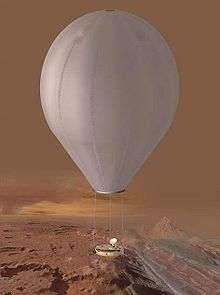
The initial Dragonfly conception took place over a dinner conversation between scientists Jason W. Barnes of Department of Physics, University of Idaho (who had previously made the AVIATR proposal for a Titan probe) and Ralph Lorenz of Johns Hopkins University Applied Physics Laboratory, and it took 15 months to make it a detailed mission proposal.[14] The Principal Investigator is Elizabeth Turtle, a planetary scientist at the Johns Hopkins Applied Physics Laboratory.[12]
The Dragonfly mission builds on several earlier studies of Titan mobile aerial exploration, including the 2007 Titan Explorer Flagship study,[15] which advocated a Montgolfière balloon for regional exploration, and AVIATR, an airplane concept considered for the Discovery program.[2] The concept of a rotorcraft lander that flew on battery power, recharged during the 8-Earth-day Titan night from a radioisotope power source, was proposed by Lorenz in 2000.[16] More recent discussion has included a 2014 Titan rotorcraft study by Larry Matthies, at the Jet Propulsion Laboratory, that would have a small rotorcraft deployed from a lander or a balloon.[17] The hot-air balloon concepts would have used the heat from a radioisotope thermoelectric generator (RTG).[18]
Leveraging proven rotorcraft systems and technologies, Dragonfly will use a multi-rotor vehicle to transport its instrument suite to multiple locations to make measurements of surface composition, atmospheric conditions, and geologic processes.[19]
Dragonfly and CAESAR were the two finalists for the New Frontiers program Mission 4,[20][21] and on 27 June 2019, NASA selected Dragonfly for development; it will launch in April 2026.[10]
Funding
The CAESAR and Dragonfly missions received US$4 million funding each through the end of 2018 to further develop and mature their concepts.[20] NASA announced the selection of Dragonfly on 27 June 2019, to build and launch in April 2026.[21][20][10] Dragonfly will be the fourth in NASA's New Frontiers portfolio, a series of principal investigator-led planetary science investigations that fall under a development cost cap of approximately $850 million, and including launch services, the total cost will be approximately $1bn.[22]
Science objectives
Titan is an analog to the very early Earth, and can provide clues to how life may have arisen on Earth. In 2005, the European Space Agency's Huygens lander acquired some atmospheric and surface measurements on Titan, detecting tholins,[23] which are a mix of various types of hydrocarbons (organic compounds) in the atmosphere and on the surface.[24][25] Because Titan's atmosphere obscures the surface at many wavelengths, the specific compositions of solid hydrocarbon materials on Titan's surface remain essentially unknown.[26] Measuring the compositions of materials in different geologic settings will reveal how far prebiotic chemistry has progressed in environments that provide known key ingredients for life, such as pyrimidines (bases used to encode information in DNA) and amino acids, the building blocks of proteins.
Areas of particular interest are sites where extraterrestrial liquid water in impact melt or potential cryovolcanic flows may have interacted with the abundant organic compounds. Dragonfly will provide the capability to explore diverse locations to characterize the habitability of Titan's environment, investigate how far prebiotic chemistry has progressed, and search for biosignatures indicative of life based on water as solvent and even hypothetical types of biochemistry.[5]
The atmosphere contains plentiful nitrogen and methane, and strong evidence indicates that liquid methane exists on the surface. Evidence also indicates the presence of liquid water and ammonia under the surface, which may be delivered to the surface by cryovolcanic activity.[27]
Design and construction
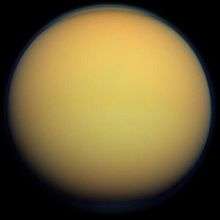
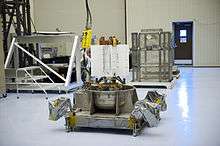
Dragonfly will be a rotorcraft lander, much like a large quadcopter with double rotors, an octocopter.[2] Such redundant rotor configuration will be able to tolerate the loss of at least one rotor or motor.[2] Each of the eight rotors will be about 1 m in diameter.[2] The aircraft will travel at about 10 m/s or 36 km/h and climb to an altitude of up to 4 km.[2]
The aerial flight on Titan is aerodynamically benign as Titan has low gravity, low winds, and its dense atmosphere allows for efficient rotor propulsion.[28] The RTG power source has been proven in multiple spacecraft, and the extensive use of quad drones on Earth provides a well-understood flight system that is being complemented with algorithms for independent actions in real-time.[28] The craft will be designed to operate under space radiation and temperatures averaging 94 K (−179.2 °C).[28]
Titan's dense atmosphere and low gravity means that the flight power for a given mass is a factor of about 40 times lower than on Earth.[2] The atmosphere has 1.45 times the pressure and about four times the density of Earth's, and local gravity (13.8% of Earth's) will make it easier to fly, although cold temperatures and lower light must be contended with.[18] Also a higher atmospheric drag on the craft has to be taken into account. The rotorcraft could travel significant distances, powered by a battery that will be recharged by a Multi-Mission Radioisotope Thermoelectric Generator (MMRTG) during the night.[29] MMRTGs convert the heat from the natural decay of a radioisotope into electricity, although increased mass and surface area might sacrifice control.[2] The rotorcraft will be able to travel tens of kilometers on every battery charge and stay aloft for a few hours each time.[5] The vehicle will use sensors to scout new science targets, returning to the original site until new landing locations are verified as safe by mission controllers.
Preliminary studies and modeling contemplate a baseline 450 kg (990 lb) mass for the rotorcraft packed in a 3.7 m diameter heatshield.[2] Samples will be obtained by two sample acquisition drills and hoses, one on each landing skid, for delivery to the mass spectrometer instrument.[2]

The craft will remain on the ground during the Titan nights, which last about 8 Earth days or 192 hours.[2] Activities during the night may include sample collection and analysis, seismological studies like diagnosing wave activity on the northern hydrocarbon seas[30], meteorological monitoring, and local microscopic imaging using LED illuminators as flown on Phoenix lander and Curiosity rover.[2][31] The craft will communicate directly to Earth with a high-gain antenna.[2]
The Penn State Vertical Lift Research Center of Excellence is responsible for rotor design and analysis, rotorcraft flight-control development, scaled rotorcraft testbed development, ground testing support, and flight performance assessment.[32]
Scientific payload
- DraMS (Dragonfly Mass Spectrometer) is a mass spectrometer to identify chemical components, especially those relevant to biological processes, in surface and atmospheric samples
- DraGNS (Dragonfly Gamma-Ray and Neutron Spectrometer), is a set of a Gamma-ray spectrometer and a neutron spectrometer to identify the surface composition under the lander
- DraGMet (Dragonfly Geophysics and Meteorology Package) is a suite of meteorological sensors and a seismometer
- DragonCam (Dragonfly Camera Suite) is a set of microscopic and panoramic cameras to image Titan's terrain and scout for scientifically interesting landing sites
Landing site


The Dragonfly rotorcraft will land at a dark dune field region called Shangri-La.[4] It will explore this region in a series of flights of up to 8 km (5.0 mi) each, and acquire samples from compelling areas with a diverse geography. After landing it will travel to the Selk impact crater, where in addition to tholin organic compounds, there is evidence of past liquid water.[4]
The Selk crater is a geologically young impact crater 90 km (56 mi) in diameter, is located about 800 km (500 mi) north-northwest of the Huygens lander[34] (7.0°N 199.0°W).[35][33] Infrared measurements and other spectra by the Cassini orbiter show that the adjacent terrain exhibits a brightness suggestive of differences in thermal structure or composition, possibly caused by cryovolcanism generated by the impact —a fluidized ejecta blanket and fluid flows, now water ice.[34][36] Such a region featuring a mix of organic compounds and water ice is a compelling target to assess how far the prebiotic chemistry may have progressed at the surface.[4]
See also
- Atmosphere of Titan
- AVIATR
- Mars Helicopter Ingenuity – a rotorcraft planned to land on Mars in 2021
- CAESAR (spacecraft) – A proposed sample-return mission to a comet
- Huygens (spacecraft) – European reconnaissance lander sent to Saturn's moon Titan; medium-class mission in the ESA Science Programme
- Titan Saturn System Mission
- Oceanus (Titan orbiter)
References
- "GAO-20-405, NASA: Assessments of Major Projects" (PDF). GAO. 29 April 2020. p. 37. Retrieved 30 April 2020.
- Dragonfly: A Rotorcraft Lander Concept for Scientific Exploration at Titan (PDF). Ralph D. Lorenz, Elizabeth P. Turtle, Jason W. Barnes, Melissa G. Trainer, Douglas S. Adams, Kenneth E. Hibbard, Colin Z. Sheldon, Kris Zacny, Patrick N. Peplowski, David J. Lawrence, Michael A. Ravine, Timothy G. McGee, Kristin S. Sotzen, Shannon M. MacKenzie, Jack W. Langelaan, Sven Schmitz, Larry S. Wolfarth, and Peter D. Bedini. Johns Hopkins APL Technical Digest, 34(3), 374-387.
- Christopher J. Scott; Martin T. Ozimek; Douglas S. Adams; Ralph D. Lorenz; Shyam Bhaskaran; Rodica Ionasescu; Mark Jesick; Frank E. Laipert. "Preliminary Interplanetary Mission Design and Navigation for the Dragonfly New Frontiers Mission Concept" (pdf). researchgate.net. AAS-18-416 (preprint)
- NASA's Dragonfly Will Fly Around Titan Looking for Origins, Signs of Life. Grey Hautaluoma and Alana Johnson, NASA. Press release 27 June 2019.
- Dragonfly: Exploring Titan's Prebiotic Organic Chemistry and Habitability (PDF). E. P. Turtle, J. W. Barnes, M. G. Trainer, R. D. Lorenz, S. M. MacKenzie, K. E. Hibbard, D. Adams, P. Bedini, J. W. Langelaan, K. Zacny, and the Dragonfly Team. Lunar and Planetary Science Conference 2017.
- "Dragonfly: Titan Rotorcraft Lander". The Johns Hopkins University Applied Physics Laboratory. 2017. Retrieved 20 September 2017.
- Redd, Nola Taylor (25 April 2017). "'Dragonfly' Drone Could Explore Saturn Moon Titan". Space. Retrieved 20 September 2017.
- "NASA Invests in Concept Development for Missions to Comet, Saturn Moon Titan | News - NASA Solar System Exploration". NASA Solar System Exploration. Retrieved 20 December 2017.
- "Dragonfly And CAESAR: NASA Greenlights Concepts For Missions To Titan And Comet 67P/Churyumov-Gerasimenko". Science 2.0. 20 December 2017. Retrieved 22 December 2017.
- Bridenstine, Jim (27 June 2019). "New Science Mission to Explore Our Solar System". Twitter. Retrieved 27 June 2019.
- Brown, David W. (27 June 2019). "NASA Announces New Dragonfly Drone Mission to Explore Titan - The quadcopter was selected to study the moon of Saturn after a "Shark Tank"-like competition that lasted two and a half years". The New York Times. Retrieved 27 June 2019.
- NASA Selects Johns Hopkins APL-Led Mission to Titan for Further Development. Johns Hopkins Applied Physics Laboratory - Press release. 21 December 2017.
- Dragonfly: Exploring Titan's Surface with a New Frontiers Relocatable Lander. American Astronomical Society, DPS meeting #49, id.219.02. October 2017.
- Dragonfly APL TechDigest (PDF)
- Titan Explorer - Flagship StudyArchived 1 February 2017 at the Wayback Machine (PDF). NASA and APL. January 2008.
- Post-Cassini Exploration of Titan: Science Rationale and Mission Concepts PDF). R. Lorenz, Journal of the British Interplanetary Society, 2000, Vol. 53, pages 218-234.
- NIAC Phase 1 Final Study Report on Titan Aerial Daughtercraft. (PDF)Larry Matthies. NASA/JPL. 2014.
- Montgolfiere Aerobots for Titan Archived 22 December 2016 at the Wayback Machine (PDF). Jack A. Jones and Jiunn Jenq Wu. NASA's Jet Propulsion Laboratory.
- Langelaan J. W. et al. (2017) Proc. Aerospace Conf. IEEE
- Finalists in NASA's Spacecraft Sweepstakes: A Drone on Titan, and a Comet-Chaser. Kenneth Chang, The New York Times. 20 November 2017.
- Spacewatch: out-of-this-world drone with a Titanic task ahead The Guardian, 21 December 2017.
- Keeter, Bill (5 May 2017). "NASA Receives Proposals for Future Solar System Mission". NASA News. Retrieved 20 September 2017.
- Sarah Hörst "What in the world(s) are tholins?", Planetary Society, 23 July 2015. Retrieved 30 November 2016.
- "Tropical Methane Lakes on Saturn's Moon Titan". saturntoday.com. 2012. Archived from the original on 10 October 2012. Retrieved 16 June 2012.
- New Images from the Huygens Probe: Shorelines and Channels, But an Apparently Dry Surface Archived 29 August 2007 at the Wayback Machine, Emily Lakdawalla, 15 January 2005, verified 28 March 2005
- Dragonfly Proposed to NASA as Daring New Frontiers Mission to Titan. Matt Williams, Universe Today. 25 August 2017.
- Robert Zubrin, The Case for Mars: The Plan to Settle the Red Planet and Why We Must, p. 146, Simon & Schuster/Touchstone, 1996, ISBN 978-0-684-83550-1
- Turtle, Elizabeth P. (2019). "The Dragonfly Mission to Titan: Exploration of an Ocean World". JHU Applied Physics Laboratory. Retrieved 9 March 2019.
- Post-Cassini Exploration of Titan: Science Rationale and Mission Concepts (PDF). R. Lorenz, Journal of the British Interplanetary Society, 2000, Vol. 53, pages 218-234.
- Stähler, Simon C.; Panning, Mark P.; Hadziioannou, Céline; Lorenz, Ralph D.; Vance, Steve; Klingbeil, Knut; Kedar, Sharon (15 August 2019). "Seismic signal from waves on Titan's seas". Earth and Planetary Science Letters. 520: 250–259. arXiv:1905.11251. doi:10.1016/j.epsl.2019.05.043. ISSN 0012-821X.
- "Eyes on Titan: Dragonfly Team Shapes Science Instrument Payload". Johns Hopkins University Applied Physics Laboratory. 9 January 2019. Retrieved 15 March 2019.
- Aerospace engineers developing drone for NASA concept mission to Titan. Chris Spallino, PhysOrg. 10 January 2018.
- Impact craters on Titan. Charles A. Wood, Ralph Lorenz, Randy Kirk, Rosaly Lopes, Karl Mitchell, Ellen Stofan. Icarus, 206 (2010) 334–344. doi:10.1016/j.icarus.2009.08.021
- "Geology of the Selk crater region on Titan from Cassini VIMS observations." J.M. Soderblom, R.H. Brown, L.A. Soderblom, J.W. Barnes, R. Jaumann, Stéphane Le Mouélic, Christophe Sotin, K. Stephan, K.H. Baines, B.J. Buratti, R.N. Clark, and P.D. Nicholson. Icarus. Volume 208, Issue 2, August 2010, Pages 905-912. doi:10.1016/j.icarus.2010.03.001
- Selk. Gazetteer of Planetary Nomenclature . Accessed on 29 June 2019.
- "Crater topography on Titan: Implications for landscape evolution." C. D. Neish, R.L. Kirk, R. D. Lorenz, V. J. Bray, P. Schenk, B. W. Stiles, E. Turtle, K. Mitchell, A. Hayes. Icarus, 223 (2013) doi:10.1016/j.icarus.2012.11.030
External links
| Wikimedia Commons has media related to Dragonfly (spacecraft). |

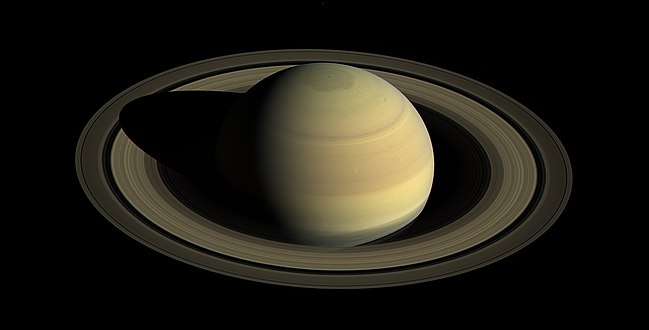
.jpg)

